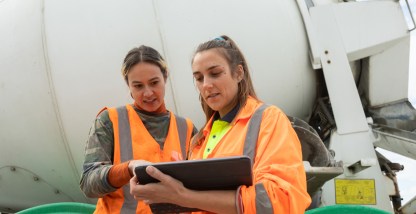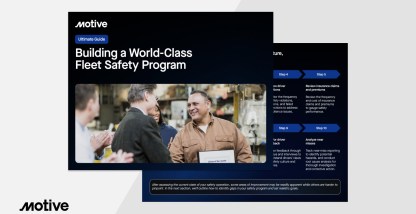When a Norfolk Southern train derailed in East Palestine, Ohio, 11 of the 38 train cars that derailed carried toxic chemicals, threatening the town’s air, soil, and water. Later, the chemicals were set ablaze in a controlled burn that sent black smoke billowing toward the sky and residents fleeing.
The incident, one of two derailments involving the railroad in a single month, set off a firestorm of debate about the impacts of precision-scheduled railroading (PSR) and a push for freight efficiency that some say compromises safety.
Transportation companies don’t have to choose between efficiency and safety. With the help of safety technology, they can maximize both.
In this story, we explore important lessons from the Norfolk Southern derailment and show how technology brings safety and efficiency together. To provide insight, we turned to two former safety execs — Don Osterberg (formerly of Schneider) and Sam Faucette (formerly of Old Dominion).
What is precision-scheduled railroading?
The Class 1 railroads introduced PSR as a strategy to drive efficiency and reduce costs. Under the program, railroads use fewer and longer trains, with fewer terminals and operators. The trains operate on fixed schedules for more consistent service. But the system carries risks.
In the PSR model, the railroads increased train length to maximize capacity. The Norfolk Southern train, for example, had 151 cars that stretched for nearly two miles. The added stress on the track and equipment increases the need for maintenance. And because crews must walk the length of the train to identify problems, making repairs mid-route isn’t feasible.
We asked Osterberg and Faucette, each with extensive fleet safety experience, to highlight key lessons from the Norfolk Southern derailment. Here are their top takeaways for the trucking industry.
1. To reduce accident severity, reduce accident frequency
When the Norfolk Southern derailment occurred on Feb. 3, it wasn’t the first time the train experienced problems on the route. On Feb. 1, after originating in Madison, Illinois, the train broke down at least once before derailing two days later. For commercial fleets, it’s a cautionary tale.
“The more frequency you have, the larger your chances of a severe accident,” says Faucette. “To improve fleet safety, you have to control accident frequency and severity over time. The key is to use safety technology to drive down frequencies as much as possible. And to keep driving them down.”
AI dash cams, for example, proactively reduce the frequency and severity of unsafe driving behaviors on the road. Fifty-four percent of dash cam customers surveyed said they’ve used dash cams to reduce cell phone use, close following, and other unsafe driving behaviors. Another 43% of respondents said dash cams have helped to reduce the frequency of accidents.
As unsafe incidents become more frequent, the level of risk rises. Not only because frequency can lead to severity. But because operators become desensitized to potential dangers.
“When fleets and operators cut corners without a negative outcome, they don’t believe anything bad will happen to them,” says Osterberg. “The reality is that cutting corners works great — until it doesn’t work. And when it doesn’t work, we have tragedies like derailments and truck crashes.”
2. Safety technology prevents accidents, improves efficiency
With tragedies and crashes come injuries, lawsuits, repair costs, high insurance premiums, and downtime. The takeaway? Safe performance isn’t only profitable, it’s productive. Accident prevention keeps your fleet moving and your people healthy.
Artificial intelligence (AI), computer vision, and automation are exactly the sorts of tools that reduce risk and keep brand names out of the headlines. Businesses can leverage AI to prevent close following, unsafe lane changes, and distracted driving in real time. Out on the road, dangers come on quickly. Through AI and automation, operators can take corrective action just as fast.
“In-cab alerts and dual-facing AI dash cams are pivotal to rooting out unsafe driving behaviors and preventing accidents,” Osterberg says. “And while some drivers push back against dual-facing dash cams, the safety insights that dash cams provide are so valuable, it’s worth it for fleets to work through any resistance they may get to enjoy their benefits.”
Unsafe driving habits like speeding, hard braking, and hard acceleration also happen to be big fuel guzzlers. Speeding alone hurts a fleet’s bottom line by running up fuel costs and requiring more maintenance. Fleets can improve fuel efficiency and cut costs by reducing unsafe driving habits and their impact. Use GPS to plan more direct routes. Rely on fuel insights to improve fuel economy and reduce fuel spending.
3. Coach drivers to root out unsafe behaviors
While the NTSB’s preliminary report didn’t indicate human error as a factor in the East Palestine derailment, it’s been said that human error causes between 80% and 90% of serious injuries and accidents.
In light of these statistics, the ability to change human behavior before unsafe habits have time to take root is crucial. Fleet safety technology alone can’t change human behavior. But frequent coaching can. Automated and in-person coaching tools like those from Motive allow drivers to grow and improve in different ways.
By accessing self-coaching tips through modern driver apps, operators can improve independently, without manager intervention. When incidents continue to occur, managers can reinforce safety expectations during an in-person coaching session.
4. Fleets can invest in accident prevention — or settle claims
With nuclear verdicts commonplace today in trucking, commercial fleets have become financial targets. It’s an unsettling thought when you stop to consider the crippling monetary impacts large verdicts and settlements have.
In 2021, a Florida jury awarded a landmark $1 billion verdict in a wrongful death case involving two trucking fleets. That’s not the norm. But even smaller verdicts can be costly. The mean payment size of smaller verdicts and settlements hovers around $427,000.
“When you recognize that the cost side of awards is going up exponentially, most fleets will be surprised to see that they’re under-investing in prevention and overpaying for failures,” Osterberg says. “Ask yourself which preventive technologies make sense to implement and err on the side of action.”
5. Safety must be a profit center, not a cost center
Fleets of all sizes and across industries believe safety is a priority. But how many of them have made safety a core value? As Osterberg notes, “priorities change, values rarely do.”
While some managers realize that investing in a strong safety program will unlock revenue opportunities and cut expenses, too many fleets view safety programs as costly “nice-to-haves.”
“The fleet operation itself has to be a profit center,” Faucette says. “If it’s not profitable, the company won’t be in business long. A successful transportation operation focuses on safety and efficiency at every department level. That’s true whether it’s maintenance, purchasing, hiring, or training.”
Profit generation comes from the hundreds of small decisions a company makes as it progresses and grows, Faucette adds. “The wise decisions will have their effect, and the costly decisions will have their effect. If not today, then sometime in the future.”
Unlock the power of safety technology
Don’t wait for a tragedy to impact your fleet. Download our Ultimate Guide to fleet safety today and err on the side of action.










